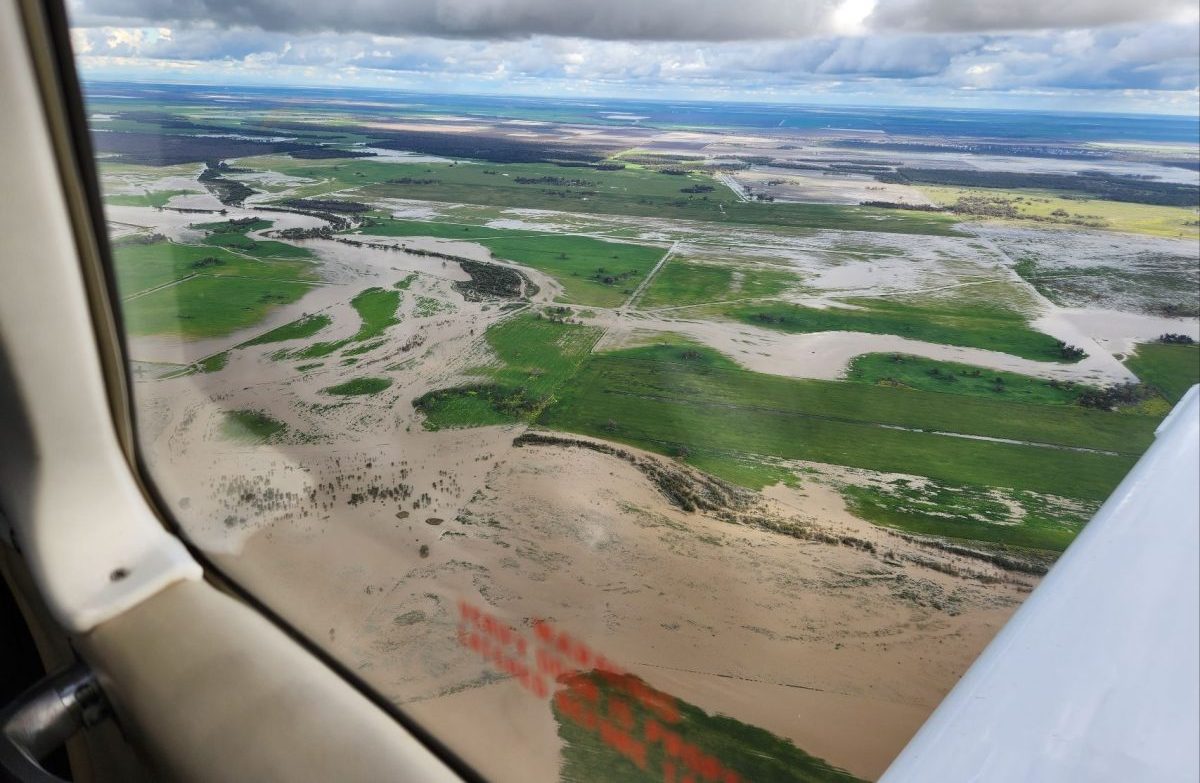
Waterlogging is affecting crops in parts of NSW and southern Queensland. Photo: John Stevenson, Namoi Cotton
MORE RAIN in southern Queensland and central and northern New South Wales, combined with the weaker Australian dollar and offshore market strength, have lifted values in the northern market this week.
In the southern market, barley is trading sideways and wheat values have softened based on consolidating prospects for bumper yields.
Trade sources say volume has been minimal, with the National Day of Mourning for Queen Elizabeth II yesterday, and the AFL Grand Final holiday in Victoria today, reducing the number of market participants on deck.
| Prompt | Sep 15 | New-crop | Sep 15 | |
| Barley Downs | $375 | $370 | $375 | $365 |
| SFW wheat Downs | $380 | $380 | $385 | $370 |
| Sorghum Downs | $370 | $362 | $350 | $355 |
| Barley Melbourne | $370 | $370 | $360 | $360 |
| ASW Melbourne | $402 | $408 | $418 | $425 |
| SFW Melbourne | $380 | $385 | $380 | $408 |
Table 1: Indicative prices in Australian dollars per tonne.
North
In the week to 9am today, rainfall of up to 50 millimetres in northern NSW and southern Queensland has created some short-term logistics headaches for consumers in the northern region.
RainAg senior commodity broker Scott Merson said rain has created some logistics issues.
“We’re trying to move stock in northern NSW, and pulling grain off farm is tricky,” Mr Merson said.
What little activity there has been in the trade this week has been tied primarily to execution, which is expected to get easier into earlier next week, when the next rain front is forecast to bring 10-25mm of rain.
While vertically-integrated feedlots are generally full, Mr Merson said some have ratcheted back.
“Some feedlots are reducing numbers and that’s leading to them being long grain.”
Another trade source global factors had lifted offer sides, and bids were not following.
“Brokers are saying it’s quiet, and growers aren’t doing much to get rid of what’s on farm with more rain on the forecast.”
Buyers and sellers are also aware of the late season getting later with every rain event.
“We were expecting to see some early barley in the first week of October; now it looks like it’ll be mid-October.”
Consumers and growers are in discussion with bulk handlers to work out which segregations will be available at soon-to-open sites.
GrainCorp this week started its 2022-23 wheat receivals with Dingo and Gindie in Central Queensland, and cereal deliveries are expected to ramp up from here on in.
Yield expectations for Queensland are well above average for many growers, with 5 tonnes per hectare likely for wheat and 6t/ha for barley where the season has been favourable right through.
South
In the southern market, Peters Commodities trader Peter Gerhardy said the cash market feels relatively firm for sound grades.
“On prompt, there’s a few shorts around.”
However, volume traded remains thin based on minimal interest on the bid side, and the four-day weekend for Victoria.
“Buyers think it’s going to go lower.”
Rain in southern NSW and Victoria in the past week was patchier and generally lighter than that in the north, but has been enough to exacerbate waterlogging concerns in low-lying areas.
“We’re not flooded, but a lot of crops are standing in water.
“Any undulating country is still OK, but the concern will be getting on the country.
“A few people have had a full profile since December last year.”
Mr Gerhardy said big carryout of wheat in NSW combined with a smaller crop this year due to some losses to waterlogging, and extended fallowing forced by wet conditions at planting in some regions, will all up make the 2022-23 crop about the same size as 2021-22’s.
However, barley will be smaller this year, based on reduced planting and lower stocks.
“Barley could have some upside.”
Bids for low-protein wheat are factoring in big stocks in NSW from carryout and new crop, and export bids are under the weight of the same scenario in Western Australia.
Cottonseed
Cottonseed asking prices in the north have gained almost 10 per cent this month as export demand for Brisbane bulk vessels trims the number of fresh offers.
Up-country sellers were quoted for October at $320/t ex Gwydir Valley and $315/t ex Namoi Valley, equating to about $380/t delivered Darling Downs.
DCT export trade was quoted about $545/t November.
“Cottonseed values have kicked higher on continued export demand and lack of offers past week,” Woodside Commodities manager Hamish Steele-Park said.
There is a small price inverse in play between nearby delivery and new crop next autumn delivery though market activity is sparse.
“The cotton crop size for next year is still looking good, although wet conditions are proving challenging for ground preparation for cotton plant.”
Grain Central: Get our free news straight to your inbox – Click here

HAVE YOUR SAY